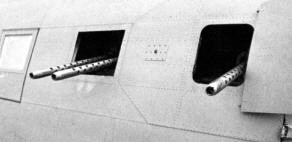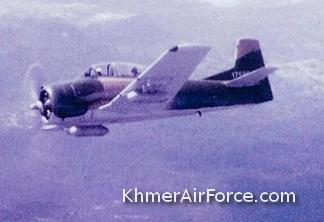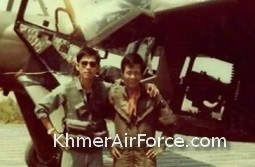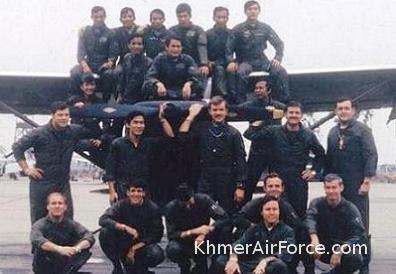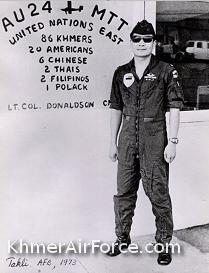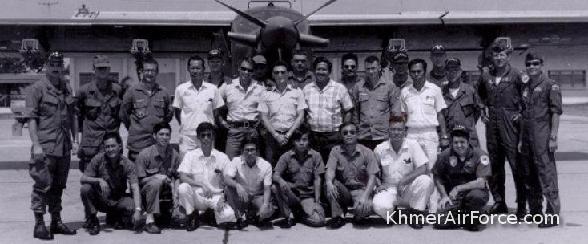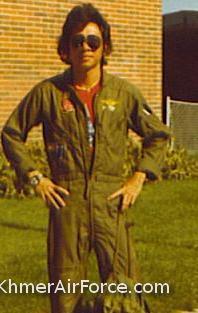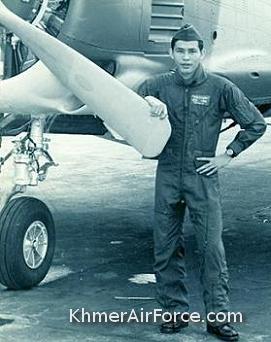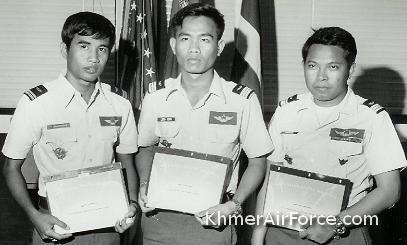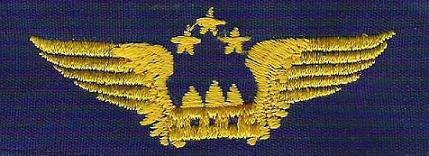 |
| Notes Anecdotes La Fin / The End |
Notes et Anecdotes
Logs and Anecdotes
|
1970 Les provinces du Nord-Est 1970 Ces
provinces éloignées furent perdues dès le début de la
guerre. Elles étaient à la limite de la portée de nos avions. Mondulkiri Le gouverneur, le Cdt Khieu Boun ainsi que tous les militaires pris n'ont donné plus aucune nouvelle. Par radio, Khieu Boun nous avait informé de la chute imminente de sa localité, puis toutes les communications furent coupées. Nous avions eu confirmation par la suite, notamment par les Renseignements américains, de la capture de quasiment toutes les garnisons et de ses avants postes. Des C-47 ont par la suite survolé la province à la recherche de survivants. Des drapeaux gouvernementaux flottaient sur certaines des positions. Des feux étaient allumés à l'approche des avions et d'en haut, la vie semblait se dérouler normalement. Trop normalement. Aucun poste radio de ces garnisons ne répondaients à nos appels. Par acquis de conscience, nous avions malgré tout largué des ravitaillements en nourriture. Rattanakiri Après à peine trois mois, la principale ville, Labansiek, fut encerclée. La population et les réfugiés furent évacués par les avions de l'AVNK, de l'USAF et de la RSVAF jusqu'à ce que la piste devienne inutilisable à cause du pilonnage adverse. La garnison et le reste de la population quittèrent la ville à pied. Labansiek est très proches de la frontière du Sud Vietnam mais avec leurs familles, les parachustistes ont mis plus de deux semaines pour décrocher et rejoindre les positions Américaines et Sud Vietnamiennes. Ils le firent tout en combattant; il y eut même trois naissances le long du périple. Ces bataillons vont rester plusieurs mois avec les Américains qui vont les rééquiper entièrement avant de les faire revenir au Cambodge. These
remote provinces were quickly fallen into enemy hands at the beginning
of the conflict. Furthermore, they were at the extreme range for our
aircraft. However, we were determined to ascertain the fate of our
troops and peoples even if we had lost all radio communications with
them. In Mondulkiri Province, the last we heard from the local governor, Major Khieu Boun, was that the North Vietnamese forces were on the verge to overran his positions. Later, thanks to US intelligence sources, we learned that all the local garrison was lost. Several of our C-47s overflew the area and reported that all seem quiet, too quiet, with no peoples seen in the streets. Cambodian flags were still flowing on top of some military positions, and sometimes unidentified peoples burned fires to attract the attention of our pilots. In the doubt, we dropped anyway some food. The town of Labansiek, in the Rattanakiri Province was put under siege by the enemy as soon as the war broke out. After less than three month, the town had to be evacuated by the USAF, AVNK and RSVAF planes until the airfield became under enemy artillery. The local garrison, reinforced by paratroopers, fought out the encirclement and marched towards South Vietnam. Even that the border was not far from the town, the trek became very difficult by continuous enemy harassments and the fact that the garrison came along with all their families and other civilians. The withdrawing column took more than two weeks. It even had three babies born. In the end, the depleted battalions reached South Vietnam where they were refurbished and re-equipped by the Americans, before being sending back to Cambodia. S.SO |
|
C'était
la fin d'une journée de missions de bombardements et de mitraillages
quand le T-28 de Ros Surabon fut touché. Il parvint à 'contrôler' son
crash. Malheureusement, la nuit tomba. L'autre T-28 perdit le
contact visuel et la communication radio fut coupée. En zone Vietcong
et Khmers Rouges, il était probablement prisonnier. Nous décidions
malgré tout de le retrouver ou tout au moins, retrouver sa trace. A
l'aube, des avions furent envoyés pour survoler la zone, mitrailler et
bombarder tout élément suspect dans le périmètre d'où provenaient les
tirs. Juste après, deux hélicoptères UH-1H débarquaient l'Adj/Chef Koy
Yi, un mécanicien qui s'était porté volontaire et un groupe de
commandos de l'Air. Le commandant du Groupement d'Intervention du GATAC
Sok Sambaur partit lui même avec ces commandos. La zone et le village
le plus proche furent inspectés. Pas âme qui vive mais Ros Surabon fût
retrouvé. Il avait été décapité. Seng Sun,
It
was late evening, during a bombing and strafing mission when the
1st/Lieutenant Ros Surabon’s T-28 was hit by enemy fire. He managed a
landing crash in Vietcong/Khmer rouge’s zone. His wingman couldn’t
locate exactly where the crash site was, and the radio contact was cut
off. With nightfall the rescue was not possible. The next day, at dawn,
a formation of T-28 was sent to clean up the area, bombing hostile
elements in the perimeter around the estimated crash site. Immediately
two UH-1H helicopters disembarked the volunteer technician warrant
officer Koy Yi and a group of commandos along with Sok Sambaur, the
Commander of the Intervention Squadron. The area and the village in the
vicinity were searched and found abandoned. The corpse of Lt. Ros
Surabon was found; he had been beheaded.
Seng Sun,
|
|
|
|
La vie quotidienne dans une Base Aérienne au début des années 70 Le changement de l’Aviation en Armée était aussi accompagné de nouvelles mesures. Les
mesures ci-dessous ont d’abord été mises en place à la BA de Pochentong
à partir de mi-1970. Elles ont été appliquées parfois avec du retard.
Certaines bases et certaines unités n'ont peut-être pas pu mettre ces
mesures en place mais il s'agissait d'une orientation que l'Armée de
l'Air voulait donner. Dans un pays en guerre avec une inflation
exponentielle, les tentations sont fortes. Des sanctions ont dû être
pris. The daily life in an Air Base at the beginning of the seventies The
below measures were first experimented at Pochentong AB at mid 1970.
Some of these measures were applied with delays. Some units and some
Air Bases may not be able to set up these measures but it was a
direction which the Air Force wanted to impulse. In a country at war
with exponential inflation, it is difficult to resist the temptations.
Sanctions were sometimes needed. |
Les Bases Aériennes de l'AAK
A l’époque française, Pochentong était la seule base aérienne mais des terrains rudimentaires sont aménagés dans les principales provinces. Ces terrains sont sous la surveillance de l’Armée de Terre. Dans les années soixante, de nouveaux terrains sont aménagés, notamment dans les provinces du nord mais l’AVRK a maintenu le principe d’une base aérienne unique. Toutefois, une "base mobile" est toujours prête pour être déployée sur un des terrains de campagne. A l’époque de l’AAK, quatre nouvelles bases aériennes furent créées. Contrairement à l’organisation française, le Commandant d’une BA était aussi le Commandant de toutes les activités sa région. A la base de Battambang, les écoles de l'AAK étaient aussi sous sa responsabilité. Durant les derniers mois, et surtout les dernières semaines de la guerre, ces bases assuraient la plupart des opérations militaires du pays car Pochentong était constamment bombardé par l’artillerie ennemie. The KAF Air Bases Since the French period, Pochentong was the only air base but there were basic airfields in key provinces. These airfields were under the Army surveillance. In the sixties, additional airfields were created, particularly in the Northern provinces but the AVRK has maintained the principle of a single Air Base. Howerver, a "mobile Air Base pack" is always ready to be deployed on any of the airstrip. During the KAF period, four new air bases were established. Unlike the French organization, the KAF AB commander also supervised operations of his region. At Battambang, the airbase commander was also head of the KAF academies. During the last months, and especially the last weeks, these bases ensured most of the military operations in the country because Pochentong was constantly under enemy fire. |
|
1971 (ou 1972?) Le Sergent traitre A
la base de Battambang, le Sgt X (nom oublié; engagé dans l'Aviation depuis les années soixante) a fourni aux KR
des indications précises sur une mission logistique des
aviateurs de la base de Battambang qui vont tomber dans un guet-apens. On trouvera
la note d'information qu'il a transmis dans la poche d'un Khmer Rouge
tué pendant l'échange de tirs. Il sera jugé par le tribunal
militaire, et condamné à être fusillé. Plusieurs aviateurs furent tués et d'autres furent blessés . |
|
...et
sa carrière de "casse-pipe". A Battambang en 1971, avec son
instructeur, le Col Son Sathan, il s'exercait à faire un 'touch and go'. A la remise
des gaz, l'hélice se détacha et le pare
brise se retrouva couvert d'huile de moteur. Avec l'assistance de
l'instructeur, il parvint à arrêter son avion juste au
bout de la piste.
Cpt Su Chhom Doeurn, the "lucky one" Cpt
Su Chom Doeurn began his eventful and distinguished career at the Air
Academy in 1971. Already, during a training sortie with his instructor,
Colonel Son Sathan, he experienced his first close-association with
cheating with death. He was being practised a series of “Touch and Go”
when during another run, when he wide opened his throttle, his
windscreen suddenly was covered by a thick coat of oil; his propeller
had broken bringing its engine to a violent stop. With the help of his
instructor, he managed to recover at the end of the runway. In 1973 he
was dispatched from Battambang as number three in his
flight, to attack an enemy ammunition depot. It was his sixth and last
missions of the day. Just after taking off, at just 1 500 feet and over
the town's governor hall, the engine of his T-28 went rough after
losing a cylinder. He acted quickly and tried a landing glide. He
deactivated and dropped his four bombs on a river and made a
crash-landing on a nearby rice field, shredding his wings when the
aircraft was arrested by a line of coconut trees. Miraculously,
he suffered only of light bruise on his head; he had forgot to tighten
the buckles of his helmet that went off on the impact. The rescue
helicopter had some difficulties to locate him for he had commandeered
a passing motorcycle and was being rode back with the driver towards
the airbase! |
|||
Les Scorpions (pilotes de chasseur-bombardier) - The Scorpions (Fighter-Bomber Pilots)
|
|
|
Helio Stallion AU-24 Unit Below photos were taken at Takli, Thailand Tiem Keam Suor (Stallion #1) |
|
|
|
|
C-123K Transport et ....bombardier !
|
Notes et Anecdotes ... Les derniers jours
Logs and Anecdotes ... The last days
